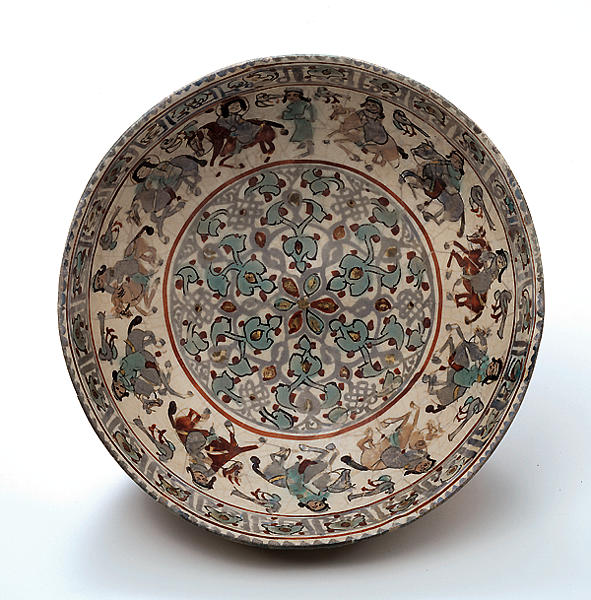色絵草葉騎馬群像図鉢
- イラン
- セルジューク朝時代
- 13c
- 複合陶土
- H-11.4 D-21
この作品は見込みにアラベルク(アラビア風の唐草模様や幾何学的な模様)を描き、その周囲に騎馬11騎の行列が描かれている。中央に6弁の円花文と放射状に淡い灰色の組紐の地文が展開している。パルメットはトルコ・ブルーで放射状に配置され、これに多数の赤い花あるいは実がちりばめられている。騎馬像の間には12羽の尾羽の長い鳥が描かれている。騎馬は交互に人物の着衣や馬の毛色を変え、変化を持たせている。鉢の口縁部内側に角張ったクーフィー体の倣文字文帯が、外側にナスヒ体の銘文が連ねられている。
Catalogue Entry
In mina'i pottery there are two main types of decoration: figural iconographic designs, and palmettes and arabesques. This bowl combines the two, with arabesques filling a medallion surrounded by a procession of eleven horsemen. A six-petaled flower is in the center, from which a pale gray ribbon branches outward as though to provide the ground color; contrasting with this are radiating palmette leaves in turquoise, and both entwine Chinese knots of eternity. To add a bit of color, numerous round red dots, representing either flowers or red berries, are scattered here and there on the palmettes. On the whole, the composition is quite tight, and a red line encircles the medallion to create a clear delineation between it and the horsemen.
It is difficult to tell if the horsemen are troops on review or are out for a hunt with hawks. A solitary standing figure, apparently a point of reference, seems to be leading the horsemen in a counterclockwise direction. There may be a special reason for the standing figure, as the same pattern is found in other processions.1 It is not clear whether the twelve long-tailed birds are placed between the horsemen simply to fill the empty space, or whether they have to do with hawking. The sense of the movement of racing horsemen is not only conveyed by the posture of the horses, it is also helped along by alternately changing the garments on the figures and the color of the horses.
On the inner rim of the bowl, there are squarish Kufic pseudo-calligraphic characters, while on the outer side is an inscription in fully curved Naskhi style. Below that, a simplified palmette pattern in red contrasts with the black of the inscription. A bowl a with central arabesque design encircled by a similar procession of six horsemen can be found in the Archaeological Museum in Tehran.2
TS
1. Enthroned figure in the center of a bowl, surrounded by eleven horsemen in counterclockwise procession, on an overglazed painted bowl, in the Freer Art Gallery; see Atil l973, pl. 35.
2. Sugimura 1980, pl. 77.
作品解説(エジプトのイスラーム文様)
色絵草葉騎馬群像図鉢
イラン 13世紀初期
径21.0cm
MIHO MUSEUM
肌色の胎土に白化粧を施し、着彩した鉢である。器形は、高台から器壁が斜めに立ち上がり、口縁近くで垂直になる。口縁の下1センチメートル位の外壁に、凹みの段差がある。見込みには6弁の花を中央にアラベスク文を描き、赤線で区切った外側には、11騎の騎馬人物と立っている人物1人を配し、それぞれの人物の間には、鳥が描かれている。口縁近くに、クーファ体の倣文字とアラベスクを組み合わせた文様が巡る。鉢の外側上部に黒で描かれたナスヒー体の倣文字装飾が一周し、その下には簡略化したペンダント状の装飾が赤で描かれている。騎馬人物は着衣や馬の色を変え、蹴り上げる足さばきと共に躍動感を伝えてくるが、中央のアラベスク文以外の部分は補筆が多く、所々に見られる金彩も、当初のものか定かではない。
